Read in English

इन दिनों पहाङ झमाझम बारिश में भीग रहे हैं। हर तरह के पेङ-पौधे अपने सबसे सुंदर हरे रंग को ओढे हुए हैं। बादल आसमान से उतर कर खिङकियों के रास्ते घर में घुसे आ रहे हैं। आप छोटे-छोटे खिङकी-दरवाजों वाले एक पुराने लेकिन आरामदायक घर के अंदर बैठे छत की पटाल (स्लेट) पर लगातार पङ रही बूंदों की टापुर-टुपुर का आनंद ले रहे हों तो इस भीगे-भीगे से मौसम में खाने का ख्याल आना स्वाभाविक ही है। खाने की शौकीन होने के कारण मेरे लिए अच्छा मौसम भी एक बढिया बहाना है कुछ खाने का या कम से कम खाने को याद करने का :)। कभी-कभी मुझे आश्चर्य होता है की पहाङी खाना इतना विविधतापूर्ण, स्वादिष्ट और पौष्टिक होने के बावजूद पहाङ से बाहर लोकप्रिय होने में कामयाब क्यों नहीं रहा ? शायद रंगरूप और नामों का खांटी भदेस होना इसकी एक वजह रही हो।
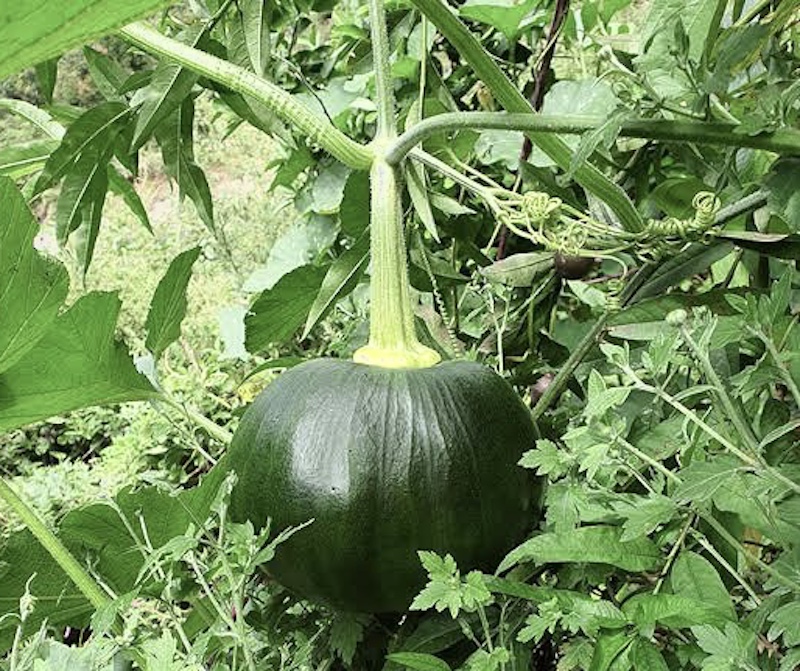
बहरहाल, आजकल खेतों में अरबी, सेम (beans), शिमला मिर्च, मूली, हरी मिर्च, बैंगन, करेला, तोरी, लौकी, कद्दू, खीरे, टमाटर, राजमा लगा हुआ है। अरबी मेरी पसंदीदा सब्ज़ी है। अरबी को स्थानीय भाषा में पीनालू कहा जाता है और मुझे नहीं लगता कि पहाङ के अलावा कहीं और इसका इतना विविधतापूर्ण इस्तेमाल होता होगा। इसका मुख्य हिस्सा जङ यानि अरबी तो खाई ही जाती है, , इसकी बिल्कुल कमसिन नन्हीं रोल में मुङी पत्तियों को तोङ कर, काट कर सुखा लिया जाता है, जिन्हें गाब या गाबा कहा जाता है। अरबी के के तनों को काट कर सुखा लिया जाता है, जिन्हें नौल कहते हैं। नौल और गाबे की सब्ज़ियों का लुत्फ सर्दियों में उठाया जाता है जब ठंड की वजह से खेतों में सब्ज़ियां बहुत कम होती हैं। इनकी तरी वाली सब्ज़ी चावल के साथ खाई जाती है।
मूली को आमतौर पर सलाद के रूप में खाया जाता है लेकिन कुमाऊंनी खाने में (मोटी जङ वाली मटियाले रंग की पहाङी मूली) यह इतनी गहरी रची-बसी है कि बरसात और जाङों में खाई जाने वाली लगभग सारी सब्ज़ियों चाहे वह राई या लाई की पत्तियां हों या आजकल खेत में हो रही ऊपर लिखी हुई कोई भी सब्ज़ी के साथ मिला कर पकाई जाती है। मूली के साथ इन सब्ज़ियों का मेल बहुत अजीब सा सुनाई देता है न? लेकिन यकींन मानिए खाने में ये लाजवाब होती है। दरअसल पहाङी मूली मैदानी इलाकों में उगने वाली सफेद, सुतवां, नाजुक सी दिखने वाली रसीली मूलियों से न केवल रंगरूप में बल्कि स्वाद में भी बिल्कुल अलग होती हैं। सिर्फ मूली को सिलबट्टे में हल्का सा कुटकुटा कर मेथीदाने से छौंक कर बना कर देखिए, इसे थचुआ मूली कहते है, न कायल हो जाएं स्वाद के तो कहिएगा। मूली को दही के साथ भी बनाया जाता है।
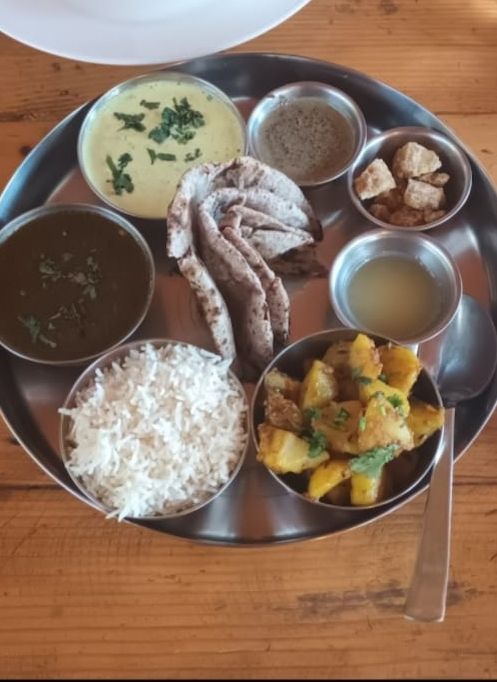
पहाङी जीवन-शैली की तरह ही यहां का खाना भी सादा और आडंबररहित होता है। यही इसकी खासियत भी है। किसी भी सब्ज़ी को किसी के साथ भी मिला कर बनाया जा सकता है, पिछले हफ्ते मैं नैनीताल गई थी, रात को उमा चाची ने मुंगोङी आलू की रसेदार सब्ज़ी के साथ बींस, शिमला मिर्च और मूली की मिली-जुली सब्ज़ी खिलाई, आनंद आ गया। सब्ज़ियों का यह तालमेल केवल एक पहाङी घर में ही बनाया जा सकता है। कुछ सब्ज़ियां मेरे ख्याल से केवल पहाङ में ही होती हैं जैसे गीठी और तीमूल। बेल में लगने वाले गीठी भूरे रंग की आलूनुमा सब्ज़ी होती है जिसे एक खास तरीके से पकाया जाता है। तीमूल को पहले राख के पानी के साथ उबाल लेते हैं और उसके बाद उसे किसी भी अन्य सब्ज़ी की तरह छौंक कर सूखी या तरीवाली सब्ज़ी बना लेते हैं, बहुत ही स्वादिष्ट बनती है। एक और सब्ज़ी होती है पहाङ में जो खूब बनाई-खाई जाती है वो है गडेरी, मैदानी इलाकों के लोग उसे शायद कचालू के नाम से पहचानेंगे। भांग के बीजों को पीस कर उसके पानी को गडेरी के साथ पकाया जाए तो इसका स्वाद कुछ खास ही होता है।
लोकप्रिय पहाङी खानों में भट्ट (काला सोयाबीन) की चुङकानी, जंबू और धुंगार जैसे मसालों से छौंके आलू के गुटके, कापा (बेसन भून कर बनाया गया पालक का साग), दालें पीस कर बनाई गई बेङुआ रोटी इत्यादि शामिल हैं। पहाङी व्यंजनों में डुबकों का अपना खास मुकाम है। यह भट्ट, चना और गहद की दाल से बनते है, डुबके बनाने के लिए दाल को रात भर भिगा कर सुबह पीस लेना होता है और फिर इसे खास तरह का तङका लगा कर हल्की आंच में काफी देर तक पकाया जाता है। इसके अलावा उङद की दाल को पीस कर चैंस बनाई जाती है।
पहाङी खाने में चटनी की खास जगह है, चाहे वह शादी ब्याह में बनने वाली मीठी चटनी सौंठ हो या भांग के बीजों (इनमें नशा नहीं होता, गांजा भांग की पत्तियों से बनाया जाता है) को भून कर पीस कर बनाई गई चटपटी चटनी। इन दिनों पेङों पर दाङिम (छोटा, खट्टा अनार) लगा हुआ है, धनिया और पुदीना के पत्तों के साथ इसकी बहुत स्वादिष्ट चटनी बनती है। पहाङों में बङा नींबू जिसे मैदानी इलाकों में गलगल भी कहा जाता है बहुतायत से होता है। सर्दियों की कुनकुनी धूप में नींबू सान कर खाना एक अद्भभुत अनुभव होता है। इसके लिए नींबू को छील कर इसकी फांकों के छोटे-छोटे टुकङे कर लेते हैं, साथ में मूली को धो-छील कर लंबे पतले टुकङों में काट कर नींबू के साथ ही मिला लेते हैं। भांग के बीजों को तवे पर भून कर सिलबट्टे पर हरी मिर्च और हरी धनिया पत्ती, नमक के साथ पीस लेते हैं। अब इस पीसे हुए भांग के नमक को नींबू और मूली में मिला लेते हैं। अब एक कटोरा दही को इसमें मिला लेते हैं। स्वाद के मुताबिक थोङी सी चीनी अब इसमें मिला लीजिए और सब चीजों को अच्छी तरह से मिला लीजिए। इसके लाजवाब स्वाद के लिए मेरे पास शब्द नहीं हैं खुद जायका ले कर देखें।
इन दिनों यहां खीरे हो रहे हैं, पहाङ में खीरे को ककङी कहा जाता है और यह आमतौर पर मिलने वाले खीरे से आकार में दो-तीन गुना बङा होता है। जब खीरे नरम होते है तो उन्हें हरे नमक यानी धनिया, हरी मिर्च और नमक के पीसे मिश्रण के साथ खाया जाता है। खीरे जब पक जाते हैं तो उनका स्वाद हल्का सा खट्टा हो जाता है अब यह बङियां बनाने के लिए बिल्कुल तैयार है। इसे कद्दूकस करके रात भर भिगाई गई उङद की दाल की पीठी में हल्की सी हल्दी, हींग इत्यादि मिला कर छोटी-छोटी पकौङियों की शक्ल में सुखा लिया जाता है। बाद में आप इसे मनचाहे तरीके से बना सकते हैं।
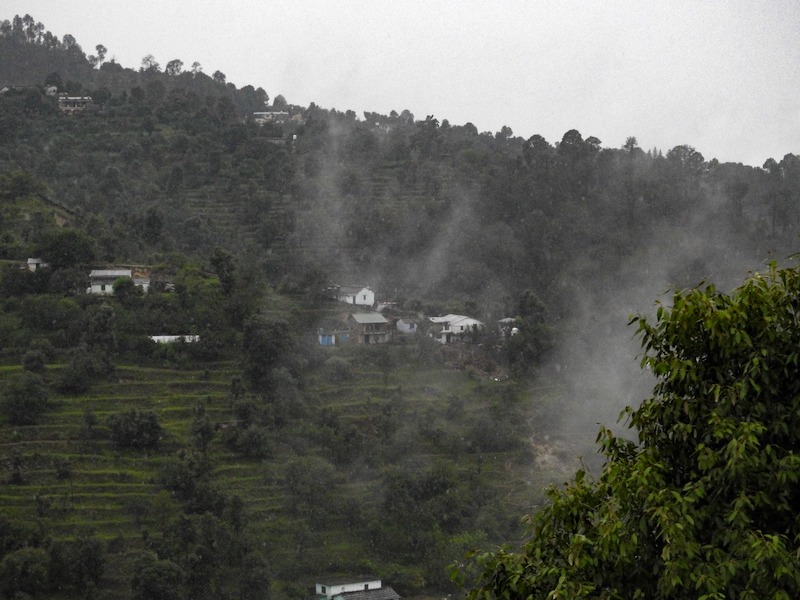
मुझे खाने का शौक है और खास तौर पर पहाङी खाना बहुत ही ज्यादा पसंद है उसमें भी सबसे ज्यादा पसंद है रस-भात। रस दरअसल बहुत सारी खङी दालों से बनता है। इसके लिए पहाङी राजमा, सूंठ (पहाङ में होने वाली सोयाबीन की एक किस्म), काला और सफेद भट्ट, उङद, छोटा काला चना, गहत इत्यादि दालों को अच्छी तरह से धो कर रात में ही भिगा दिया जाता है। सुबह उसी पानी में मसाले डाल कर चूल्हे की हल्की आंच में काफी देर तक उसे पकाया जाता है जब सारी दालें पक जाती हैं तो पानी को निथार कर अलग कर लिया जाता है। दालों का यही पानी रस कहलाता है जिसे शुद्ध घी में हल्की सी हींग, जम्बू और धूंगार के पहाङी मसालों का तङका लगा कर गरमा-गरम चावलों के साथ खाया जाता है।
फिलहाल इतना ही, फिर किसी और दिन करेंगे चर्चा कुछ और पहाङी व्यंजनों की। बाहर बारिश तेज़ हो गई है।
Pahadi Food Amidst Pitter-Patter of Rain
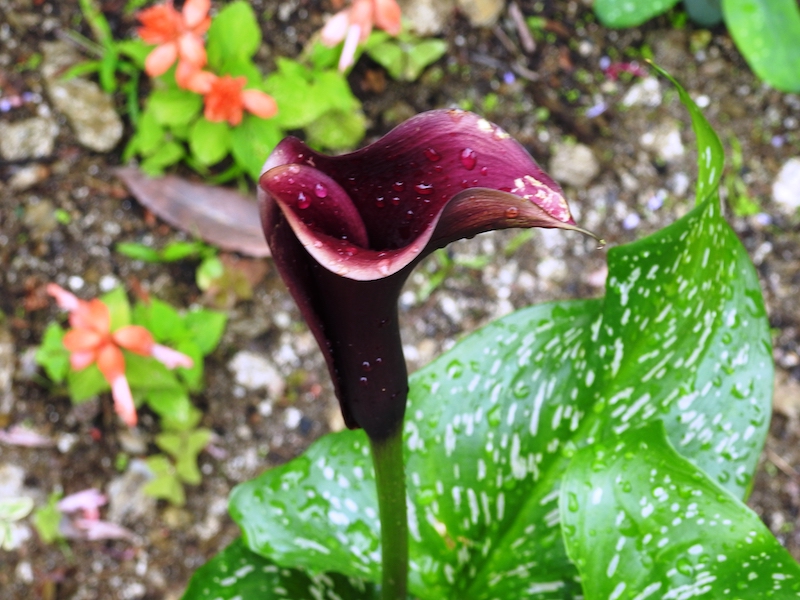
These days the mountains are drenched in rain. The myriad trees and plants are clad in a bountiful green colour. Clouds are descending from the sky and entering the house through the windows. If you are sitting inside an old but comfortable house with small windows and doors, enjoying the tapur-tupur of the continuous raindrops on the slate roof, then it is natural to think of eating. Being a foodie, good weather is also a good excuse for me to indulge my passion, physically or at least, mentally. Sometimes I wonder why Pahadi food, despite being so diverse, delicious and nutritious, has not managed to become popular outside Pahad? Perhaps the form and colour, or the names have not created appeal.
However, nowadays Arbi, beans, capsicum, radish, green chillies, brinjal, bitter gourd, ridge gourd, bottle gourd, pumpkin, cucumbers, tomatoes, kidney beans are planted in the fields. Arbi is my favorite vegetable. Arbi is called pinalu locally, and I do not think that it would be used so diversely anywhere except in the mountains. The main part of it is the root i.e. Colocasia, which is cooked and eaten. The tender curled leaves are plucked, cut and dried in small rolls, which are called Gaab or Gaaba. The stems are cut and dried, which are called Naul. Vegetables of naul and gaab are enjoyed in winters when there are very few vegetables in the fields because of the cold. Made into a vegetable curry, it is eaten with rice.
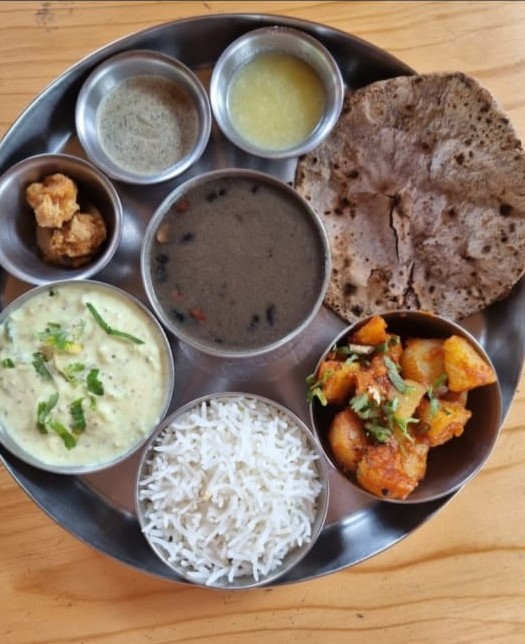
Radish is usually eaten in the form of salad. But in Kumaoni food the reddish mountain radish with thick root can be cooked with almost all vegetables eaten in monsoons and winters, be it mustard or lye leaves. It is cooked in combination with any of the above mentioned vegetables growing in the fields. The mix of these vegetables with radish sounds strange, doesn’t it? But believe me, it is wonderful to eat. In fact, mountain radishes are completely different from the white, juicy, delicate-looking radishes that grow in the plains, not only in colour but also in taste. Just try making radish by lightly pounding it and sprinkling it with fenugreek seeds, it is called Thachua muli. If this does not weave its magic, tell me. Radish is also made with curd.
Like the lifestyle in the mountains, the food here is also simple and without ostentation and flourish. This is also its speciality. Any vegetable can be combined with anything. Last week I went to Nainital, and my aunt, Uma chachi, cooked a mixed vegetable of beans, capsicum and radish along with a Moongoni potato curry. Pure joy. These unusual combinations of vegetables are probably only cooked in a Pahadi kitchen. Some vegetables are likely grown only in the mountains, like Githi and Teemul. Vine-grown githi is a sweet brown potato-like vegetable which is cooked in a special way. Teemul is first boiled in water mixed with wood-ash. After that it is made into a dry or curried vegetable, and is incredibly tasty. There is another vegetable which is prepared and eaten in the mountains, Gaderi, probably better recognised as Kachalu by people in the plains. Grinding hemp seeds and cooking it with gaderi, makes it very special.
Popular Pahadi dishes include chukani of bhatt (black soybean); potato chunks seasoned with spices like jambu and dhungar; kapa, a dish made from spinach and gram flour fried into dumplings; begua roti made of ground pulses, etc. Dubka has its own special place in Pahadi cuisine. Made from bhatt, chana and gahad dal. To make the dubka, the dals are soaked overnight and ground in the morning and then cooked for a long time on a low flame with special sesoning. Apart from this, chais is made by grinding urad dal.
Chutney has a special place in Pahadi food, whether it is the sweet chutney or the spicy chutney made by roasting and grinding hemp seeds (the seeds are not intoxicating. Ganja is made from hemp leaves). These days daadim (small, sour pomegranate) is growing on the trees, and a very tasty chutney is made from it with coriander and mint leaves. Big lemon in the mountains, which is also called galgal in the plains, is abundant. Eating lemon juice in the scorching sun of winter is a wonderful experience. For this, peel the lemon and cut its slices into small pieces, wash and peel radish and cut it into long thin pieces and mix it with the lemon. Roast hemp seeds on a griddle and grind them with a grinding stone, with green chilies and green coriander leaves, salt. Now mix powdered hemp salt in lemon and radish. Add a bowl of curd to it. Add sugar according to taste and mix everything well. I have no words for its wonderful taste. Try it yourself.
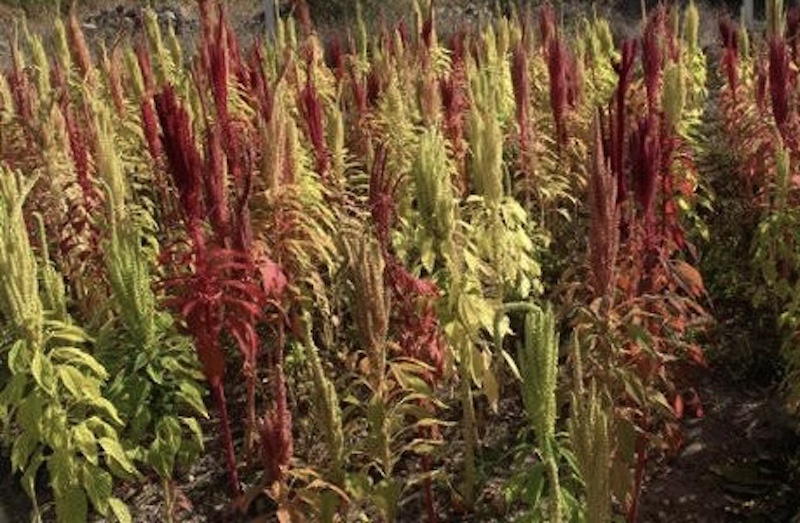
Cucumbers are being grown here these days. Cucumber is called kakhri and it is two-three times larger than the commonly found cucumber. When cucumbers are soft, they are eaten with green salt i.e. a ground mixture of coriander, green chilies and salt. When cucumbers get ripe, their taste becomes slightly sour, and they are ready to make into Badis. Grate it and season it with turmeric, asafoetida and pahadi spices in ghee, soaked overnight with urad dal and then rolled into dumplings which are then sun-dried and ready to be added to any dish.
I am fond of food and I especially like pahadi food, among which a favourite is ras-bhat. It is made from several raw pulses like Pahadi Rajma, Sunth (a variety of soybean found in Pahad), black and white bhatta, urad, small black gram, wheat etc. These are washed thoroughly and soaked at night. In the morning, add spices to the same water and cook it for a long time on a low flame, preferably on a wood fire chulha or stove. When the pulses are cooked, the water is drained and separated. This water of pulses is called ras or juice, to which is added asafoetida, jambu and dhangar, Pahadi spices spluttered in pure ghee.
Some other day we will talk of other pahadi food. It has started raining heavily outside.